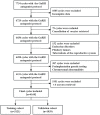A prediction model for high ovarian response in the GnRH antagonist protocol
- PMID: 38047110
- PMCID: PMC10693331
- DOI: 10.3389/fendo.2023.1238092
A prediction model for high ovarian response in the GnRH antagonist protocol
Abstract
Backgrounds: The present study was designed to establish and validate a prediction model for high ovarian response (HOR) in the GnRH antagonist protocol.
Methods: In this retrospective study, the data of 4160 cycles were analyzed following the in vitro fertilization (IVF) at our reproductive medical center from June 2018 to May 2022. The cycles were divided into a training cohort (n=3121) and a validation cohort (n=1039) using a random sampling method. Univariate and multivariate logistic regression analyses were used to screen out the risk factors for HOR, and the nomogram was established based on the regression coefficient of the relevant variables. The area under the receiver operating characteristic curve (AUC), the calibration curve, and the decision curve analysis were used to evaluate the performance of the prediction model.
Results: Multivariate logistic regression analysis revealed that age, body mass index (BMI), follicle-stimulating hormone (FSH), antral follicle count (AFC), and anti-mullerian hormone (AMH) were independent risk factors for HOR (all P< 0.05). The prediction model for HOR was constructed based on these factors. The AUC of the training cohort was 0.884 (95% CI: 0.869-0.899), and the AUC of the validation cohort was 0.884 (95% CI:0.863-0.905).
Conclusion: The prediction model can predict the probability of high ovarian response prior to IVF treatment, enabling clinicians to better predict the risk of HOR and guide treatment strategies.
Keywords: GnRH antagonist protocol; controlled ovarian stimulation; high ovarian response; nomogram; prediction model.
Copyright © 2023 Jiang, Cui, Guo, Wang and Zhang.
Conflict of interest statement
The authors declare that the research was conducted in the absence of any commercial or financial relationships that could be construed as a potential conflict of interest.
Figures




Similar articles
-
Performance of prognostic modelling of high and low ovarian response to ovarian stimulation for IVF.Hum Reprod. 2018 Aug 1;33(8):1499-1505. doi: 10.1093/humrep/dey236. Hum Reprod. 2018. PMID: 30007353
-
Ovarian response prediction in GnRH antagonist treatment for IVF using anti-Müllerian hormone.Hum Reprod. 2015 Jan;30(1):170-8. doi: 10.1093/humrep/deu266. Epub 2014 Oct 29. Hum Reprod. 2015. PMID: 25355590
-
Dose Nomogram of Individualization of the Initial Follicle-Stimulating Hormone Dosage for Patients with Polycystic Ovary Syndrome Undergoing IVF/ICSI with the GnRH-Ant Protocol: A Retrospective Cohort Study.Adv Ther. 2023 Sep;40(9):3971-3985. doi: 10.1007/s12325-023-02582-2. Epub 2023 Jul 3. Adv Ther. 2023. PMID: 37395872 Free PMC article.
-
Prognostic models for high and low ovarian responses in controlled ovarian stimulation using a GnRH antagonist protocol.Hum Reprod. 2014 Aug;29(8):1688-97. doi: 10.1093/humrep/deu090. Epub 2014 Jun 5. Hum Reprod. 2014. PMID: 24903202 Free PMC article.
-
Comparison of anti-Müllerian hormone and antral follicle count in the prediction of ovarian response: a systematic review and meta-analysis.J Ovarian Res. 2023 Jun 27;16(1):117. doi: 10.1186/s13048-023-01202-5. J Ovarian Res. 2023. PMID: 37370145 Free PMC article.
Cited by
-
Ginsenoside Rg1 Alleviates Hydrogen Peroxide-Induced Autophagy and Apoptosis in Ovarian Granulosa Cells.Cell Biochem Biophys. 2025 Jun 27. doi: 10.1007/s12013-025-01803-5. Online ahead of print. Cell Biochem Biophys. 2025. PMID: 40571901
References
Publication types
MeSH terms
Substances
LinkOut - more resources
Full Text Sources

